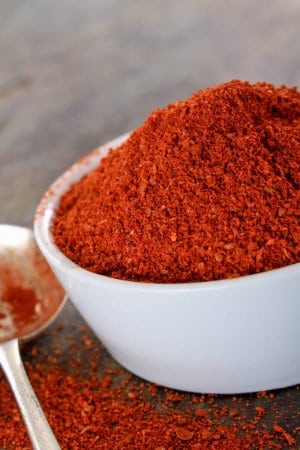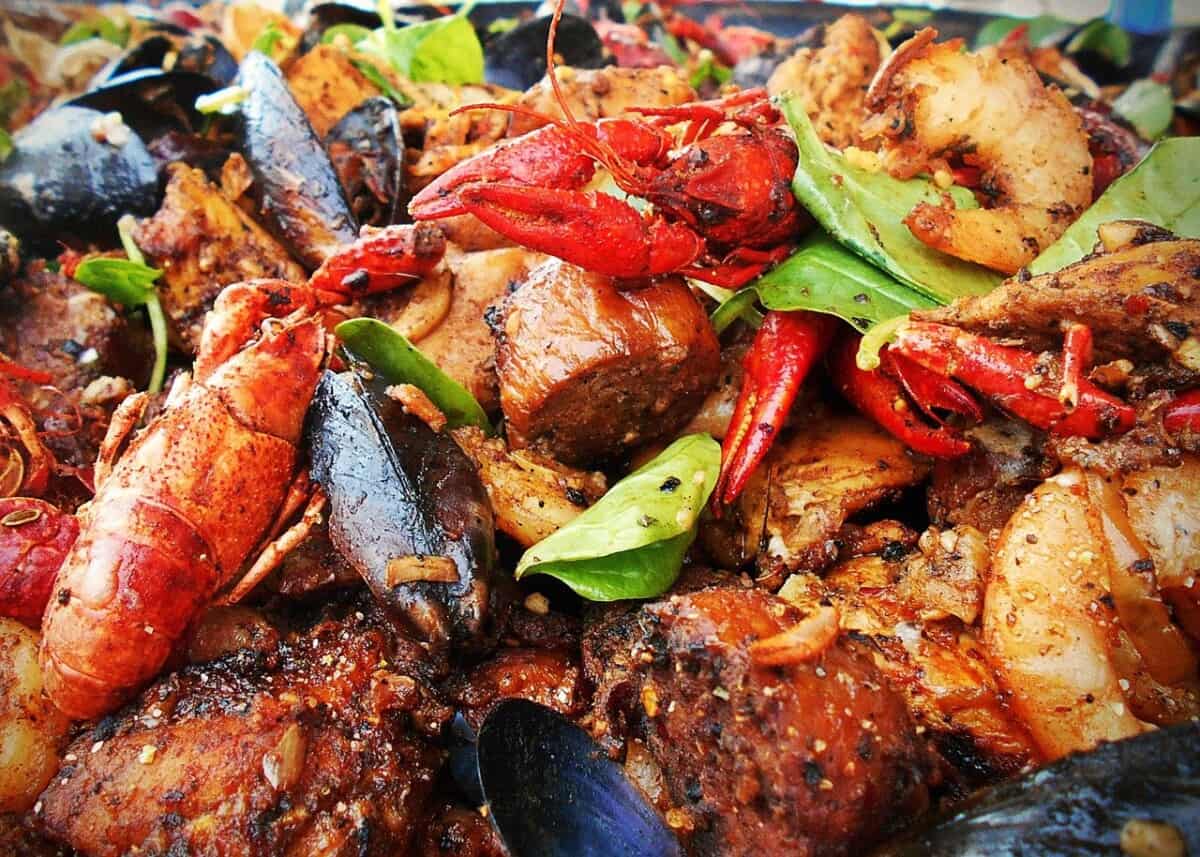Difference: Cajun Dry Rub & Cajun Wet Rub?
The purpose of a dry rub is to create a crust; it enhances the flavor without adding moisture. Wet rubs contain some of the same seasonings as the dry rub, but it has a liquid base like vinegar or oil.
Generalizing Barbecue
“Real barbecue” (as distinguished from grilling) involves cooking meat in an “enclosed,” humid space under low, constant temperatures (usually around 175 to 250 °F (79.4 to 121 °C). (1) This ensures that the meat’s fat and connective tissue dissolves and that the meat virtually falls off the bone when it is done and when it is finished cooking. Barbecue is never served rare.
Barbecue refers to a cooking method, but people use the term to describe the goods as well. In the Southwest, barbecue typically means barbecued beef, and in the South, it is barbecued pork. However, you can also barbecue fish, poultry(2), tofu, and root vegetables.
Cajun Dry Rub or Cajun Wet Rub
Often, the debate about barbecue is whether a wet rub or a dry rub is better. What exactly is the difference? It is simple: dry is without sauce, wet is with sauce. And the region where you are dining influences the fare. Rubs are primarily for the use of controlling flavor. They are a pivotal factor to distinguishing grilling from barbecuing.(1) They can offset the flavor lost or covered up due to using a gas grill or charcoal. (3)
The Cajun Dry Rub

What is it? A Cajun dry rub creates a crust to hold in moisture. It’s a flavor enhancing mixture of herbs and spices. Dry rubs are a wonderful way to “spice up” your next round of grilled meats. But they are quite a different thing from marinades in the flavor they impart, the texture they leave on the meat and the way they are used. In fact, it is safe to say that if you do not have time to marinate, Cajun dry rubs are a fantastic, “last minute” method of seasoning meats quickly and easily.
There are two ways to use a dry rub: Use them as their name indicates. Dry! Simply rub and press or sprinkle the spices onto your meat covering the entire surface. This will give you a nice “crust” on your meat. And if you add a little unrefined sugar to that, that crust will caramelize a bit as well. Or you can add a dab of oil.
Mix a small amount of oil with the rub to form a paste that you can easily spread over your meat. The result will not give you a crusty topping, but it will give you plenty of flavor.
When to try a Cajun dry rub? A Cajun dry rub is great on food that is cooked faster, hot, and hasty; much like on a gas grill.(4) Generally, it’s used on food that does not need to be tenderize, namely shrimp or a thick chicken breast. I love a good crispy crunch on fish regardless of its flakiness or oiliness. Many people who grill know that either rub style will work well with fish, also.
However, the dry rub adds a flare of taste to the outside leaving the pure taste inside intact. Messing with the natural flavor and juices in a fresh, tender steak is a no-no, therefore, a light dry rub is recommended as to not disturb the natural taste.
What is in it? Universal ingredients are paprika, dry mustard, chili powder, cumin, garlic and onion powders, black, white, and lemon peppers, salt, coriander, dried lemon, or lime zest, sage and thyme; cayenne and brown sugar are optional. Do use your own twist by improvising the ingredients to your liking. Make it flavorful by trusting your palate.
Approximately six to ten herbs and spices make up most dry rubs. Paprika is most often used as the base of any recipe that you will find. Why? Because Paprika brings smoky flavor all on its own.
I encourage you to fuse together your own secret dry rub recipe. Start with less is more; you can add more spice, but you can’t take it out. Start with a basic recipe, taste it, and tweak it.
Hint: add more paprika for a stronger, smokier flavor and watch it take the rub turn closer to a blackening color. A tightly sealed container that locks out moisture works best for long term storage. Only you can control the spicy kick; add cayenne pepper to your desired heat level.
How do I use it? By hand and before grilling, massage the rub onto the surface of your chosen meat. The more time the rub sits on the meat, the more time it spends mingling means the more time your letting the flavors sink in.
Last minute preparations tips:
- An extremely hot cooking surface aides the savory, crispy crust.
- A lowered grate that’s as close to the coals as possible creates a hotter fire cooking surface.
Crank up the heat, hear that hissing sound? That’s the flames searing the meat. It’s a lovely, pleasing to a griller’s ears. Also, by cranking up the heat the first couple of minutes and cooking on each side, the flames will darken and sear the rub into the skin quickly. That slightly smoldering smell is ground peppers and paprika sizzling to perfection.
Hint: Watch your meat. Move it to a cooler spot in the grill or decrease the temperature when the outside looks dark enough.
The Cajun Wet Rub

What is it? Taking your dry rub ingredients from above, add just about any liquid to moisten. You now have a wet rub.
Is wetter better? The wet rub attains its full potential when applied generously. This allows it to cook in slowly. (4) Slow cooking, the flawless method for flavoring meat all the way through, draws the moisture from the rub while creating a charring on the outside. Ribs, pork chops and bone-in chicken seek a wet rub. Pulling a juicy, well glazed pork chops or sticky, bronzed sparerib off the grill, is well worth the wait.
Vegetables, such as portabella mushrooms or zucchini,(27) that are mostly water benefit from an added wet rub. A dry rub will not stick to this type of vegetable. Because they are already so moist, they don’t need as much time on the grill to cook.
What makes it wet? The wet or moisture ingredient can be your choice. Beer, wine, bourbon, soy sauce, cider vinegar, vegetable oil (peanut, olive, canola etc.) Worcester sauce, honey, molasses, Dijon mustard, tomato sauce, fruit juice, melted butter and so on, are all a perfect choice. Hint: Don’t add too much liquid or your wet rub in drip off during the cooking process.
How do to apply it? Using a basting brush, brush, slather or coat your entire piece of meat. I recommend wrapping it in plastic and letting it rest in the fridge for at least one to two hours before grilling. Hint: Re-brush or re-coat whenever you like and especially when you flip it over.
You need to know that the wet rub will absorb the flavor from a charcoal or soaked wood chips fire. You want to allow time for your wet rub to form a dark outer layer. This allows time for moisture, aroma, and flavor to be soaked up. I recommend a smoking or slow cooking process for this reason.
Hint: A rub that’s high in sugar such as brown sugar or honey you should set the temperature lower (less than 350 °F (176.6 °C). This will ensure a nice caramelization of the rub instead of burning.
The important thing is knowing how, knowing when, and rubbing well. Creating, mixing, and cooking with your own flavors will add loveliness to your dry or wet rub.

